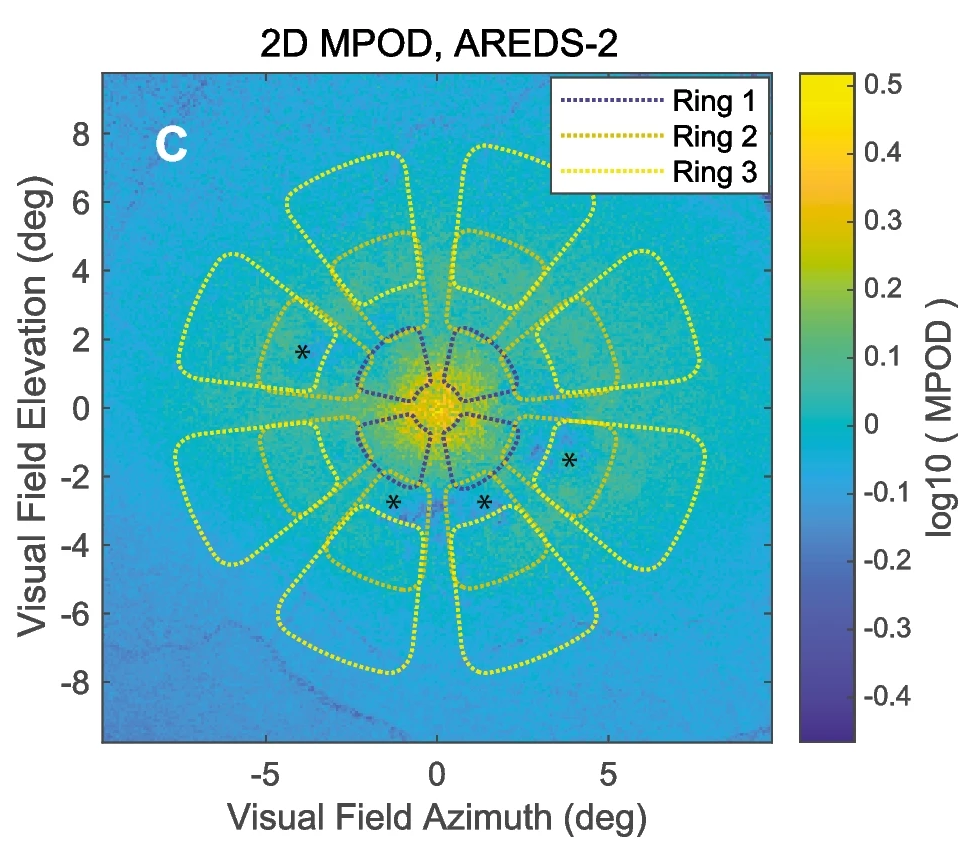 |
|
Several MPOD measures produced good diagnostic power for discriminating earlier from later-stage AMD. This image from the study overlays the objective perimetry stimuli pattern (the dartboard-style layout) over a map of macular pigment optical density. Photo: Rai BB, et al. Graefes Arch Clin Exp Ophthalmol. March 14, 2024. Click image to enlarge. |
Researchers of a recently published study assessed the diagnostic power of macular pigment optical density (MPOD) measurement and a new diagnostic concept called multifocal pupillographic objective perimetry for different age-related macular degeneration (AMD) severities. The study also recorded standard perimetry and best-corrected visual acuity (BCVA) results.
An investigational device called the ObjectiveField Analyzer (OFA) from Konan Medical provided objective perimetry results and the Heidelberg Spectralis OCT autofluorescence mode measured MPOD in 58 eyes of 29 AMD patients. MPOD data was expressed in a two-dimensional (2D) map. Both OFA and 2D-MPOD were conducted twice over an average of about one year. Extracted from each MPOD image were 20 regions/macula matched to the 20 OFA stimuli/macula.
Average age of participants was 71.6 years. The study authors found significant correlation between macular pigment and OFA sensitivities for different severities of the Age-Related Eye Disease Studies (AREDS) grading scale, which has four levels; delays showed correlations with level 2. For level 4, correlations extended across all eccentricities. After analysis, there was found to be significant changes in MPOD over the period of the study, especially variability measures. MPOD per-region medians were able to discriminate AMD level 1 from level 3 eyes at a rate better than OFA, perimetry and BCVA.
Essentially, MPOD changes correlated with central functional changes and these correlations extended peripherally in later-stage AMD. As the authors note in their paper on the work, “good diagnostic power for earlier-stage AMD and significant change over the study suggest that 2D-MPOD and OFA may provide effective biomarkers.”
Since retinal changes can occur due to AMD before BCVA changes, the authors relay that new measures are needed to provide clinical endpoints for intermediate AMD. One of the main findings of this study was significant correlations with OFA measures and change over the year. However, another thing to point out was that macular pigment measures could reasonably distinguish AMD level 3 and level 4 eyes from level 1. This, combined with other observed data, suggests that MPOD measures could be suitable for clinical endpoints in studies of interventions in intermediate AMD over the course of a one-year time period.
The researchers also bring up how this would be an advantage for the overall economic impact that late-stage AMD is estimated to cause. In the US, this rate was estimated to be $49.1 billion in 2022; it affects almost 10% of those in developed countries over 65 years and 25% of those older than 75. In developing countries, AMD is very common, with it being the fourth most common retinal disorder in Bhutan.
Developed countries manage the burden of a large amount of AMD cases, but developing countries experience limited human resources and accessibility to standard healthcare services. The authors convey that with these results, “diagnostic approach such as 2D-MPOD with high diagnostic power capable of identifying at-risk eyes, or clinching diagnosis of early-stage AMD, would be beneficial to both the developed and developing countries. It can potentially reduce blindness and visual impairment, visual disability and economic impact.”
Rai BB, Sabeti F, van Kleef JP, et al. Comparing 2-dimensional macular pigment optical density with objective and subjective perimetry and visual acuity in age-related macular degeneration. Graefes Arch Clin Exp Ophthalmol. March 14, 2024. [Epub ahead of print]. |


